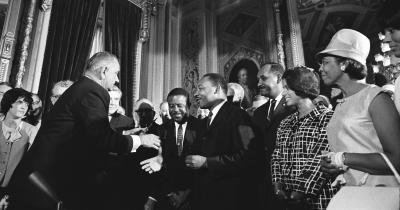
Honor the Voting Rights Act by Restoring Its Anti-Racist Core
Breaking down what made the Voting Rights Act so powerful, how the Supreme Court gutted it, and what can be done to restore it.

Today marks the 54th anniversary of the Voting Rights Act of 1965 (VRA), the most effective racial justice statute passed in American history.
The VRA should not have been necessary. The Fifteenth Amendment, which was ratified in 1870, prohibits discrimination in voting based on race. It boldly proclaims, “The right of citizens of the United States to vote shall not be denied or abridged by the United States or by any state on account of race, color, or previous condition of servitude.” Also in 1870, Mississippi elected the nation’s first Black senator, Hiram Rhodes Revels, and South Carolina elected its first Black congressperson, Joseph Rainey. According to historian Eric Foner, during Reconstruction about 2,000 Black men held an official position in government.
When political compromise brought a premature end to Reconstruction, however, southern states devised a myriad of ways to disenfranchise Black Americans. Whites regained control of state legislatures and used a combination of poll taxes, literacy tests, residence and property restrictions, white primaries, racial gerrymanders, and racial-terror violence to strip Black people of the vote and destroy their political power.
It was not until Congress passed the Voting Rights Act of 1965, at the height of the Black Freedom Struggle, that the Fifteenth Amendment’s promises became real.
It was not until Congress passed the Voting Rights Act of 1965, at the height of the Black Freedom Struggle, that the Fifteenth Amendment’s promises became real. The VRA prohibits all voting practices and procedures that have the purpose or effect of discriminating based on race. The centerpiece of the bill is Section 5, which requires that states and localities with a history of discriminatory voting practices “preclear” any changes in election procedures with the U.S. Department of Justice or the federal district court in D.C. before implementing those changes. In these preclearance proceedings, the jurisdiction bears the burden of proving that the proposed changes do not have a discriminatory purpose and would not be “retrogressive”—meaning would not diminish the voting strength of voters of color.
Section 5 is premised on the reality that voter suppression is systemic and difficult to root out. By stopping this discrimination before it starts, the preclearance requirement is affirmatively anti-racist.
The VRA had an immediate impact. The nonwhite (predominantly Black) voter registration rate increased dramatically across the south from 1964 to 1966-67. For example, in Mississippi that measure went from 6.7 percent to 59.8 percent; in Alabama it went from 19.3 percent to 51.6 percent. The VRA even resulted in 20-point bumps in the white voter registration rate in many states. Candidates preferred by Black voters began running and winning in jurisdictions where that would have been unthinkable just years earlier. Slowly, state legislatures and Congress began to look more like America.
In 2013, the Supreme Court gutted the VRA’s preclearance requirement in Shelby County v. Holder.
In 2013, the Supreme Court gutted the VRA’s preclearance requirement in Shelby County v. Holder. The 5-4 majority left Section 5 intact, but struck down the VRA’s formula (in Section 4(b) of the Act) for determining which jurisdictions were required to preclear electoral changes. Despite the extensive record gathered by Congress and the 98-0 reauthorization vote in the Senate in 2006, Chief Justice Roberts determined that the coverage formula was based on “decades-old data and eradicated practices,” and concluded that it no longer spoke to “current conditions.” “Today,” he wrote, “our Nation has changed.” The Court therefore struck down the coverage formula on federalism grounds and what Roberts described as “the fundamental principle of equal sovereignty” requiring the federal government to treat states similarly. Since Shelby County, the VRA’s preclearance regime has been out of commission, and procedural changes ranging from new photo ID procedures to discriminatory districting have been allowed to go into effect freely across the previously covered jurisdictions.
In her dissent in Shelby County, Justice Ginsburg wrote that “[t]hrowing out preclearance when it has worked and is continuing to work to stop discriminatory changes is like throwing away your umbrella in a rainstorm because you are not getting wet.” She was right—and it has continued storming.
Two hours after the Supreme Court’s decision, then state Attorney General Greg Abbott announced that Texas should be able to implement a strict voter ID law that a court had blocked under preclearance. The following day, North Carolina pushed a groundbreaking new omnibus voter suppression bill that became known as the “monster” law. Federal courts later found both laws to be intentionally discriminatory against voters of color. The Fourth Circuit Court of Appeals ruled that the monster bill targeted Black voters “with almost surgical precision.”
Responding to intentional, race-based voter suppression requires an energetic democracy movement and fearless litigation. It also requires that we restore the Voting Rights Act to stop discriminatory practices before they go into effect. The Voting Rights Advancement Act, a bill pending in Congress as H.R. 4, would do this by enacting a new coverage formula and mandating that certain practices known to be discriminatory be submitted for preclearance regardless of the jurisdiction seeking to implement them.Discriminatory voter suppression continues at crisis levels. Earlier this year, Demos and our partners sued to stop a voter purge program in Texas, which falsely claimed that almost 100,000 non-citizens were registered to vote and over half had voted, and threatened to kick naturalized citizens—overwhelmingly people of color—off the voting rolls. In 2018, then-Georgia Secretary of State Brian Kemp presided over his own race for governor against Stacey Abrams, deploying aggressive voter purges and unreasonable signature-matching protocols that disproportionately denied voters of color the ability to cast a ballot.
In 2016 we had the first presidential election since 1965 without the full protections of the Voting Rights Act. We cannot afford another election in which voter suppression is permitted to fester in our states and distort outcomes. We must come together to restore the VRA and build a democracy in which all voters have equal influence in our electoral system.



